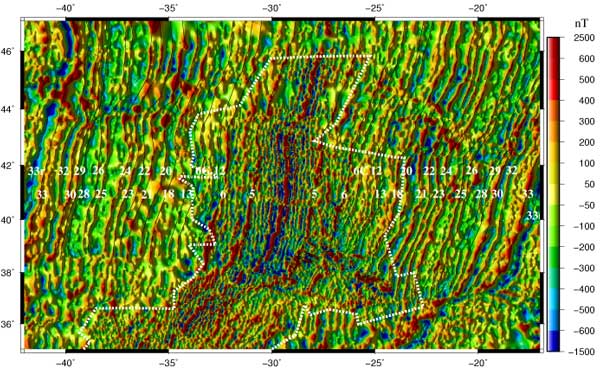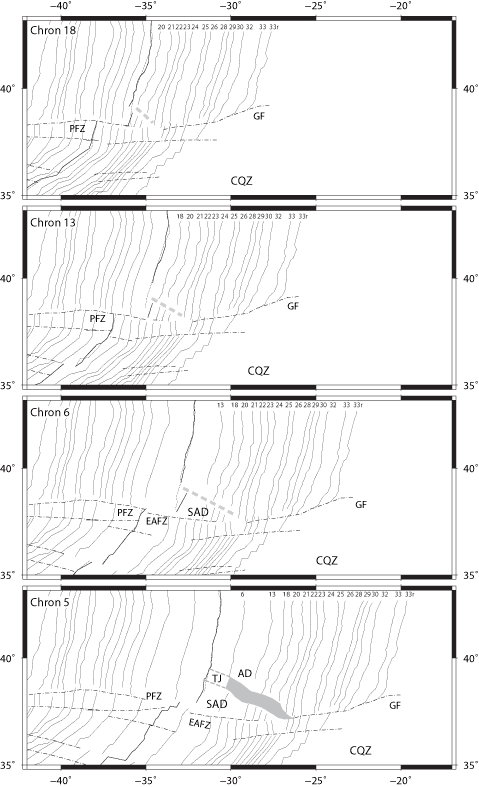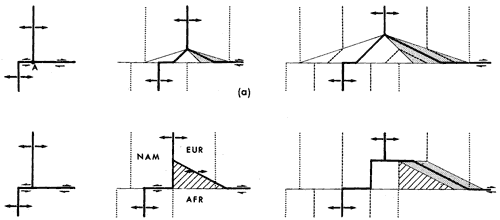 |
Re-evaluation
of magnetic chrons in the north Atlantic between
35ºN and 55ºN: implications for the
development of the Azores |
Joaquin F. Luis1
& J.M. Miranda2
1University of Algarve,
CIMA, Campus de Gambelas, 8000 Faro, Portugal, jluis@ualg.pt
2University
of Lisbon, CGUL, IDL, Lisboa, Portugal, jmmiranda@fc.ul.pt
We present a new magnetic compilation
for an area of the north Atlantic between 35°N
and 47°N
and up to anomaly 34. Magnetic anomalies, when accurately
mapped, still represent the best source of information
about the time evolution of complex geological domains,
and this is the case for the Azores Triple Junction.
To pick magnetic isochrons and compute finite rotation
poles we applied a slightly heterodox approach, enhancing
magnetic anomaly identification with a continuous reduction-to-the-pole
technique. This takes into account the magnetic latitude
variation within the study area and the direction of
remnant magnetization, assuming that all magnetic
rocks were generated at the ridge and acquired magnetization
according to the geocentric dipole model. This allowed
us to “pick” a large number of magnetic
anomalies and to compute a new set of rotation poles
that describe well Iberia-North-America relative
motion. The final result is displayed in Figure 1,
on which the anomaly picks made in this work are overlain.

Figure 1: Magnetic anomalies continuously
reduced to the pole. Overlain are the polylines whose
vertices correspond to the anomaly picks along the
magnetic isochrones. White dashed line encompasses
the area where new magnetic data have been added
to the existing compilation. Click here or on
Figure for enlargment.
The first question we
address concerns the location, in the Eurasian plate,
of the newly formed Azores lithosphere. In principle,
the easiest way to answer this question would be to
map magnetic anomalies in the plateau and identify
magnetic striping sub-parallel to the Azores trend.
This has was looked for by Krause & Watkins (1970)
but not found. Our compilation shows why: the Azores
plateau displays two different magnetic zones, one
north of ~ 38°N where there are "Azorean" magnetic
anomalies close to the topographic highs and with
no systematic organization (the Azores Domain–AD)
and the other south of this (the South Azores Domain–SAD)
where magnetic anomalies are MAR-like. The obvious
conclusion is that the newly formed Azores lithosphere
is presently located in the AD.
The second question concerns
the relationship between the Pico Fracture Zone and
the East Azores Fracture Zone between Chrons 22 and
5. The similarity between the trends of the magnetic
anomalies in the AD and the SAD suggests that
they correspond to the same spreading regime. This
means that homologues of each of North American Chrons
5 to 22 can be found in the Eurasian plate, split by
Azores extensional processes into two branches, one
now located in the AD and the other
within the SAD. Figure 2 shows
successive configurations of the Azores plateau, where
it can be (quantitatively) seen that at the time of
Chron 13 both the Pico Fracture Zone and the East Azores
Fracture Zone had spatial continuity.

Figure 2: Magnetic reconstructions
at Chrons 18, 13, 6 and 5. The set of rotation
parameters used for Africa and the SAD
are taken from Klitgord & Schouten (1986). Anomalies
of the SAD are rotated using the same
set of parameters as Africa, which presumes
that any extension between the SAD
and the northern border of the African plate is not
compensated.
The third question concerns
the onset of Azores spreading. To understand better
the extension imposed on the Azores by differential
motion between the Iberian and African plates we computed
the successive dimensions and strikes of a segment
that connects the southern end of Iberian Chron
21 with the northern end of African Chron 21. The
time evolution of this segment, that presently crosses
S. Miguel Island, gives an interesting “Lagrangian” description
of the changes in stretching and direction of
extension. The results are plotted in Figure 3, where
it can be seen that only after Chron 6 did significant
extension take place in the Azores. Its average value
can be simply estimated from the data plotted in Figure
3 as close to 4.1 mm/yr for the period Chron 6 - Chron
5 and 3.5 mm/yr for the period Chron 5 - Chron 5. The
direction of extension can also be estimated as close
to 50°N for the period Chron 6 - Chron 0 and 68°N
for the period Chron 5 - Chron 0. Thus, the onset of
the Azores extensional regime appears to follow the
welding of Iberia to Eurasia, corresponding to a sharp
change of extensional velocity.

Figure 3: Time evolution
of a segment that links two points fixed to the Iberian
and Africa plates for the period between
Chrons 21 and 0. The length is indicated in km
and the azimuth in degrees.
The very slow development of a
large lithospheric block did not generate
the conventional magnetic striping that is characteristic
even of very slow spreading regimes (e.g.,
the Southwest Indian Ridge). From the magnetic compilation
it is clear that only the most recent magnetic epochs
(the Brunhes and Matuyama) are observable in the Azores
domain and mainly in its northern limb. This favours
an interpretation whereby the evolution of the Azores
plateau had two separate phases:
- where
no coherent discrete magmatic features were created
and predominantly extensional motion occurred. This
was most probably related to the development of the
deep basins along the whole central and southern
parts of the Azores domain, and
- a very recent phase, concentrated
on the northern limb of the Azores domain, that is
associated with the presently active axis, seismicity,
large topographic masses, and coherent magmatic
processes that create sharp magnetic anomalies.
The change from one phase to the other could be
related to small changes in the Eurasia-Africa spreading
direction or velocity, or changes in magma supply.
The
attempt by Luis et al. (1994)
to establish a rigid Eulerian description of the behaviour
of the small Azores block has inherent limitations
due to the small size of the study area, but nevertheless
its main conclusions are robust. Stable Eurasian
plate behaviour can today be found north of the Azores
domain, and stable African behaviour south
of the East Azores Fracture Zone–Gloria Fault.
Within the Azores area, the now-slowly developing spreading
regime affects a large area that encloses newly formed
lithosphere (the Azores domain) and previous Eurasian
lithosphere split by Azores extension and dragged by
the stable African plate. To describe the motion of
the Azores domain by a set of rigid Eulerian rotations
we need a set of parameters that is different from
the stable Iberian and African plates.
This interpretation is similar to
the interpretative sketch of Searle (1980)
(Figure 4) but the time evolution
is more constrained, the build-up of the Azores domain
occurs off the mid-Atlantic Ridge, and it is connected
not by a discrete transform boundary but by a more
complex tectonic domain. The lack of evidence for a
discrete triple junction already suggested (Searle,
1980; Luis et al.,
1994) and the amount of extension in the Azores domain,
either magmatic or amagmatic, supports the model
of Lourenço et al. (1998) and Vogt & Jung (2003)
of the Azores axis as a plate boundary acting both
as an oblique, ultraslow spreading center and a transfer
zone accommodating dextral differential Eurasian-African
shear motion.

Figure 4: Interpretive sketch of
Searle (1980) illustrating the evolution of the Azores
triple junction.
References
-
Krause, D. and N. Watkins (1970),
North Atlantic crustal genesis in the vicinity
of the Azores, Geophys. J.
Royal Astron. Soc., 19, 261–283.
-
Lourenço, N., J.F. Luis,
J.M. Miranda, A. Ribeiro and L.A. Mendes Victor
(1998), Morphotectonic analysis of the Azores Volcanic
Plateau from a new bathymetric compilation of the
area. Mar. Geophys. Res., 20, 141-156.
-
Luis, J.F., J.M. Miranda,
P. Patriat, A. Galdeano, J.C. Rossignol, L. Mendes
Victor (1994), Açores
Triple Junction Evolution in the last 10 Ma from
a New Aeromagnetic Survey, Earth
Planet. Sci. Lett., 125,
439-459.
-
Searle, R. (1980), Tectonic
pattern of the Azores spreading centre and triple
junction, Earth Planet. Sci. Lett., 51, 415-434.
-
Vogt, P.R., W.Y. Jung (2003),
The Terceira Rift as hyper-slow, hotspot-dominated
oblique spreading axis: A comparison with other
slow-spreading plate boundaries. Earth Planet.
Sci. Lett., 218, 77-90.
last updated 15th
December, 2008 |
